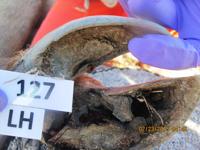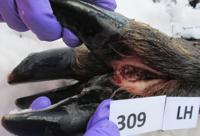Wildlife biologists are watching Yakima County elk herds for signs of an incurable disease that leaves the animals lame or limping on deformed, overgrown and broken hooves.
The bacteria that causes the disease had plagued the dairy industry for decades, but had never been documented in elk or any other hooved wildlife until the late 1990s. But starting in 2008, biologists noticed a dramatic increase in infections among elk herds in southwest Washington. The disease, known as Treponeme associated hoof disease or TAHD, has not surfaced in Yakima County, but state officials are asking hunters and others to report any sign of elk with hoof deformities.
Since 2008, the debilitating infection has spread to at least 11 Western Washington counties as well as eastern Oregon, and it’s clearly a contributor to shrinking herds in certain areas. While much remains unknown, significant research efforts and funding aim to illuminate the dangers of the disease — and hopefully find a way to stop it.
The disease doesn’t appear to affect humans, and the meat of infected animals remains safe to eat. But concern over its impact is enough that Gov. Jay Inslee directed Washington State University’s College of Veterinary Medicine to take the lead in research and authorized more than $1.5 million in funding. University spokesman Charlie Powell said the school expects to hire one of five finalists as its lead scientist for the program within a month.
Research challenges
Identifying diseased elk and accurately counting populations can be difficult, but the Wildlife Department collected data using several strategies.
The state Department of Fish and Wildlife has used an online reporting system since 2012, sent volunteers into the field to look for diseased elk about three years ago, questioned hunters who collected the hooves of harvested elk, and conducted aerial surveys to find limping elk. The department also added a question about elk hoof disease to its mandatory annual hunting reports for permit holders.
“I think it’s important to realize that most of the diagnostic work has been done, which is looking at what the cause is likely to be,” Powell said. “Patience is a key in any disease research, whether it’s in humans or animals because typically the way that disease begins is complex, not simple.”
A big breakthrough in discovering the origin of the state’s unique elk hoof disease came in 2014, when scientists at the University of Liverpool in England found treponeme — a parasitic bacteria — in samples sent by the Wildlife Department.
Dairy farmers worldwide have been battling the bacteria in cows for three decades, and it’s been found in sheep and goats in England, but this was the first time it had been identified in elk, said Kristin Mansfield, a Wildlife Department veterinarian and epidemiologist who played a key role in identifying the bacteria responsible for the disease.
Researchers from Colorado State University and the U.S. Department of Agriculture joined the Wildlife Department in studying the disease. Wildlife Department elk hoof disease coordinator Kyle Garrison said the department also works with its tribal partners, most notably the Northwest Indian Fisheries Commission.
A serious impact
The disease manifests in elk as a digital dermatitis disease, and there’s no known treatment or vaccine.
Garrison said TAHD appears to be more infectious than another disease known as “hoof rot”, and it generally affects only one rear hoof.
The Wildlife Department’s statewide elk specialist, Brock Hoenes, said a study with more than 200 captures of 146 elk since February 2015 showed the severity of deformities that cause limping can progress rapidly, with some elk going from healthy to among the most severely affected in just a few months. In rare situations, the Wildlife Department even euthanizes afflicted animals.
“The euthanasia protocol was developed to address animals that are severely affected by the disease that are also kind of at the nexus of urban areas and human health,” Garrison said. “We tread a careful line between knowing which animals to humanely dispatch and which to not do that.”
He said the department euthanized fewer than five in the past year, and the ongoing study showed elk can often survive in even the most severe cases. However, Garrison said diseased elk proved more susceptible to dying from harsh winters, and it reduces the odds of pregnancy for females.
Those factors contributed to a decline of 35 percent of elk in the Mount St. Helens areas in 2017, which corresponded with a 35 percent decrease in hunting permits and opportunities to hunt antlerless elk. But Mansfield and Garrison caution that due to other issues such as habitat loss and food scarcity, it’s impossible to say just how much of the decline can be attributed to ATHD.
Kittitas and Yakima counties represent the state’s best elk hunting, even though drought and harsh winters led to recent declines in both counties. If the disease reaches the eastern Cascades, area hunters could help play a key role in gathering more information for researchers.
A new rule asks hunters in areas where the disease is prevalent to always leave diseased hooves on site as a precaution, and the department stopped its practice of relocating elk to avoid further spreading.
It’s unknown exactly how the disease spreads, but Mansfield recommends anyone who hunts in affected areas should carefully disinfect their vehicles, boots and packs since it could be transported through mud. Garrison stressed hunters should always look for deformities in hooves of harvested elk, noting the disease also includes “a pretty profound smell.”
“Hunters are extremely important for us to be tracking and detecting the disease and also understanding how prevalent it is and where it is established,” Garrison said, noting the reports help the department establish a map of the disease, which can be found online. “It’s not a perfect measurement of the prevalence of the disease, but it’s informative for us.”













(0) comments
Comments are now closed on this article.
Comments can only be made on article within the first 3 days of publication.